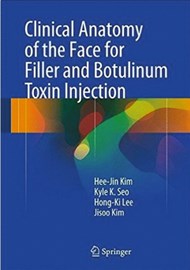This text provides an exquisite overview of clinical anatomy for aesthetic clinicians, providing cosmetic injectable treatments to an Asian population. The anatomical photography and clinical dissections convey exceptional detail of facial structures, combining embalmed and unembalmed specimens, as well as schematic diagrams. It also includes images sourced from Plastic and Reconstructive Surgery and 80 additional research papers from acknowledged journals.
The dissected specimens are of Asian descent, demonstrating variations in facial anatomy, when compared to a Caucasian subject. Most notably, Asians portray varying locations of the modiolus, different directions and locations of the facial arteries as well as different attachment regions for facial muscles, which are described in detail throughout the chapters. In addition, there is a useful section for further reading surrounding physical anthropological traits in Asians. Subsequently, many of the injection techniques described reflect technical approaches and considerations pertinent to an Asian patient, such as pretarsal injection with dermal filler.
The book begins with descriptions of aesthetic terminology, according to defined anatomical regions and encourages the reader to visualise the anatomy of the face as a series of layers with discussion of salient structures within each layer. The authors adopt a refreshing approach to describing facial anatomy; unlike other texts written specifically for an aesthetic clinician, the authors do not list the anatomy in a regional approach, chapter by chapter. Instead, they place emphasis on the relevant anatomy, which includes technical considerations with botulinum toxin and dermal filler, to treat the face safely and effectively.
The dermal filler chapter is perhaps the most extensive and breaks down the areas for treatment into the upper, mid and lower face, in a similar format to the previously described areas, with a combination of prosection, embalmed / unembalmed and schematic images. The layered concept discussed at the start of the book is incorporated here for the reader to visualise significant structures, in conjunction with surface topographical markings. Injections are performed at each facial region to emulate a dermal filler procedure, with the subsequent product exposed through dissection, which is very effective for the reader to visualise placement based upon the techniques described. Many of the techniques such as injection of the temporal fossa, injections to the mid facial region as well as the lower face are applicable to a Caucasian patient.
The chapters on sensory and motor nerve distribution of the face combine schematic and cadaveric diagrams which support the detailed chapter on performing facial nerve blocks for dermal filler treatments. Botulinum toxin indications are explored with discussion surrounding suitability for treatment and basic-advanced techniques are comprehensively demonstrated.
The final chapter discusses vascular compromise from dermal filler treatment, supported with anatomic dissection demonstrating injectate placed within vasculature surrounding the orbit. The authors have produced this text principally to guide those treating Asian patients. However, the approach can be useful for treating any patient particularly as it encourages the clinician to understand the importance of continually advancing one’s anatomical awareness to reduce the risk of complications. References to guide further reading are given at the end of each chapter. The quality of the dissections and diagrams are superb, without which, it would be more challenging for the reader to visualise the techniques described.





